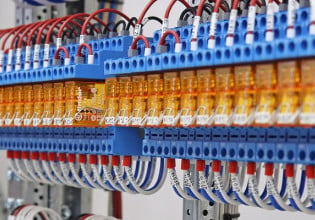SICK’s New DT80 Extends Distance Sensing Precision
Offering unprecedented range and precision, SICK’s DT80 represents a leap in accuracy and signal fidelity that goes the distance.
No matter what is emitting the signal, one drawback most distance sensors share has to do with range. Essentially the longer a distance sensor’s signal has to travel, the harder it is to sustain accuracy, resolution, and response time. However, as time and innovation march on, the distance these devices can measure accurately is being pushed farther out every day.
Sensing the Near and Far
Distance sensors, also known as proximity sensors, function by putting out an energy-based signal, bouncing it off an object, and then measuring the reflecting signal’s strength on return. Distance sensors detect the presence of objects in the vicinity without physical contact. To sense objects, a distance sensor radiates or emits a beam of electromagnetic radiation. Several familiar technologies occupy the space, including LASER, sonic navigation and ranging (SONAR), radio detection and ranging (RADAR), infrared (IR), light detection and ranging (LIDAR), ultrasonic, IR light-emitting diodes (LEDs), and vertical-cavity surface-emitting lasers (VCSLs).
Signal Quality
Distance sensors rely on range, resolution, and update rates to function and sense proximity, speed, and distance accurately.

The new DT80 distance sensor. Image used courtesy of SICK
Resolution
Resolution refers to the smallest change in distances a sensor can detect. For example, an IR LED has a resolution of about 5 mm, while a VCSL offers a 1 mm resolution.
Update Rate
Generally measured in Hz, update rates are essential to tracking moving objects accurately. Rule-of-thumb, the faster the refresh rate, the more readings per second. The faster the device can receive returning signals, the faster the device can more accurately measure speed, and time over distance.
Range
Range is a familiar metric for engineers thinking about using a distance sensor in industrial and commercial applications. Simply, range is the distance, from minimum to maximum, a sensor’s signal can be sent and returned accurately.
Distance Sensors: Everywhere You Need Them
According to Mordor Intelligence, the proximity sensor market was valued at $3.7 billion in 2020 and is expected to reach $5.7 billion at a CAGR of 7.3% by 2026. That may seem quite large, but considering how critical distance sensing is to manufacturing, processing, construction, automotive, aerospace, defense, and more, it’s not surprising the numbers aren’t higher.
I Can See for .05 Miles: Introducing SICK’s DT80
SICK, a legacy manufacturer of advanced sensing and control technologies, recently introduced a new distance sensor engineered for long-distance accuracy. Featuring a red, IEC 60825-1:2014 class 2-rated LASER, SICK’s sensor offers unprecedented range. SICK says its DT80 is designed to go the distance of 80 meters or approximately 262 feet, some .05 of a mile.
According to SICK, its DT80 sensor combines long-range with “unparalleled” precision. SICK says the device’s +/- 2 mm accuracy at a maximum range of 80 m puts its new device ahead of its competitors. Regardless, its specifications and design offer control engineers new latitude when it comes to integrating high-fidelity distance sensors into motion and safety control. Specifications at a glance include:
- Accuracy of +/- 2 mm with a maximum resolution of 0.1 mm
- Measuring ranges from 0.05 m up to 80 m on white and up to 14 m on black
- IO-Link V1.1, analog and digital output
- TFT color display and user-friendly menu navigation
- Elegant metal housing in proven design
- Protection class IP65 and IP67
Point-to-Point Intelligence for Better Integrations
Offering both analog and digital output signals, the device becomes intelligent through point-to-point communication through the IO-Link interface. Just plug the sensor into an existing IO-Link network and let the party begin. With IO-Link, control engineers can more efficiently and reliably transfer data between sensors, actuators, and the control system, making the DT80b an ideal solution for smart, Industry 4.0 applications.

Featuring both analog and digital outputs, the DT80 offers easier integrations. Image used courtesy of SICK
Applicable to Virtually Any Proximity Challenge
A versatile sensor in a compact package, the DT80 is ready for thousands of industrial, process, safety, and mobile applications. Its metal housing and IP rating ensure sensor reliability in harsh environments.
Applications extend across the universe of machine and motion control. SICK has assembled a list of example installation possibilities:
- Metal, steel: monitoring of coiling/uncoiling
- Automotive: quality control, robot gripper positioning
- Industrial vehicles: height detection on forklifts
- Consumer goods: position monitoring of molds
- Mobile machines: telescopic arm length measurement on telehandlers
- Port: container detection/positioning

SICK distance sensors are ideal for myriad applications stretching across the cast universe of motion control. Image used courtesy of SICK
SICK has been innovating sensing technologies for years, and its DT80 pushes the performance of the technology farther than before, delivering precision and accuracy at ever-greater distances. Able to withstand significant temperature fluctuations and harsh operating conditions, the devices are purpose-built for virtually any application that comes to mind.






